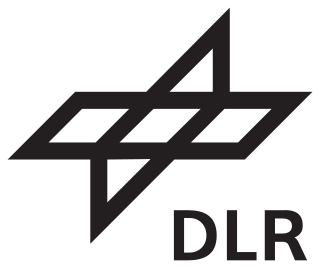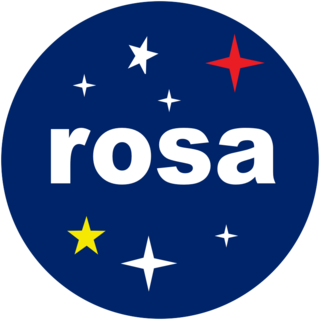Related Research Articles

Asteroid impact avoidance encompasses the methods by which near-Earth objects (NEO) on a potential collision course with Earth could be diverted away, preventing destructive impact events. An impact by a sufficiently large asteroid or other NEOs would cause, depending on its impact location, massive tsunamis or multiple firestorms, and an impact winter caused by the sunlight-blocking effect of large quantities of pulverized rock dust and other debris placed into the stratosphere. A collision 66 million years ago between the Earth and an object approximately 10 kilometers wide is thought to have produced the Chicxulub crater and triggered the Cretaceous–Paleogene extinction event that is understood by the scientific community to have caused the extinction of all non-avian dinosaurs.

The term Spaceguard loosely refers to a number of efforts to discover, catalogue, and study near-Earth objects (NEO), especially those that may impact Earth.

A laser broom is a proposed ground-based laser beam-powered propulsion system that sweeps space debris out of the path of artificial satellites to prevent collateral damage to space equipment. It heats up one side of the debris to shift its orbit trajectory, altering the path to hit the atmosphere sooner. Space researchers have proposed that a laser broom may help mitigate Kessler syndrome, a runaway cascade of collision events between orbiting objects. Additionally, laser broom systems mounted on satellites or space station have also been proposed.

The German Aerospace Center is the national center for aerospace, energy and transportation research of Germany, founded in 1969. It is headquartered in Cologne with 35 locations throughout Germany. The DLR is engaged in a wide range of research and development projects in national and international partnerships.

The Italian Space Agency is a government agency established in 1988 to fund, regulate and coordinate space exploration activities in Italy. The agency cooperates with numerous national and international entities who are active in aerospace research and technology.

Marc William Buie is an American astronomer and prolific discoverer of minor planets who works at the Southwest Research Institute in Boulder, Colorado in the Space Science Department. Formerly he worked at the Lowell Observatory in Flagstaff, Arizona, and was the Sentinel Space Telescope Mission Scientist for the B612 Foundation, which is dedicated to protecting Earth from asteroid impact events.

A sample-return mission is a spacecraft mission to collect and return samples from an extraterrestrial location to Earth for analysis. Sample-return missions may bring back merely atoms and molecules or a deposit of complex compounds such as loose material and rocks. These samples may be obtained in a number of ways, such as soil and rock excavation or a collector array used for capturing particles of solar wind or cometary debris. Nonetheless, concerns have been raised that the return of such samples to planet Earth may endanger Earth itself.

Dante S. Lauretta is a professor of planetary science and cosmochemistry at the University of Arizona's Lunar and Planetary Laboratory. He is the principal investigator on NASA's OSIRIS-REx mission.

The Romanian Space Agency is a public institution that coordinates Romania's national space technology research programs and activities related to space research. ROSA, established in 1991, is subordinate to the Romanian Ministry of Education.

Jan Charles "John" Zarnecki, is an English space science professor and researcher. Since 2013, Zarnecki has been a Director of the International Space Science Institute. Between 2004 and 2013 he was a Professor of Space Science at the Open University, having previously been a professor and researcher at the University of Kent.

Paolo Farinella was an Italian scientist very active in the field of planetary science and in particular in the study of asteroids and small bodies of the Solar System.
Gian Nicola Babini was an Italian scientist who specialised in the field of ceramics.

The Faculty of Engineering is one of the four faculties which make up the University of Strathclyde in Glasgow, Scotland. The faculty contains multiple departments offering many different undergraduate and postgraduate courses. These range from BEng, MEng and MSc courses to doctorates throughout the faculty.

Patrick Michel is a French planetary scientist, Senior Researcher at CNRS, leader of the team TOP of the CNRS and Université Côte d'Azur Lagrange Laboratory at the Côte d'Azur Observatory in Nice (France), and also a Global Fellow of the University of Tokyo.
The Space Safety Programme, formerly the Space Situational Awareness (SSA) programme, is the European Space Agency's (ESA) initiative to monitor hazards from space, determine their risk, make this data available to the appropriate authorities and where possible, mitigate the threat.
The EuroMatrixPlus is a project that ran from March 2009 to February 2012. EuroMatrixPlus succeeded a project called EuroMatrix and continued in further development and improvement of machine translation (MT) systems for languages of the European Union (EU).
The NITROS project is an ongoing project which began in November 2016 consisting of 12 Early-Stage Researchers (ESRs). It is funded through the European Union's Marie Skłodowska-Curie Actions (MSCA) research grant which is an Innovative Training Network (ITN) to support European Joint Doctorates (EJD). The collective aim of this specific MSCA scheme is for fostering new skills by means of excellent initial training of researchers.

The Smart Cities EMC Network for Training (SCENT) is a project funded by the European Union's Horizon 2020 research program under the Marie Skłodowska-Curie grant agreement No 812391. It is a Ph.D training network program in the field of Electromagnetic Compatibility (EMC) especially in the smart cities application. Three universities and twelve industries collaborate in SCENT project. Supported by the IEEE EMC Society Technical Committee 7: besides Ph.D training program, SCENT project also performs scientific training programs and social outreach programs.

Light Italian CubeSat for Imaging of Asteroids is a six-unit CubeSat of the Italian Space Agency (ASI). LICIACube is a part of the Double Asteroid Redirection Test (DART) mission and carries out observational analysis of the Didymos asteroid binary system after DART's impact on Dimorphos. It communicates directly with Earth, sending back images of the ejecta and plume of DART's impact as well as having done asteroidal study during its flyby of the Didymos system from a distance of 56.7 km (35.2 mi), 165 seconds after DART's impact. LICIACube is the first purely Italian autonomous spacecraft in deep space. Data archiving and processing is managed by the Space Science Data Center (SSDC) of the ASI.

Hera is a space mission in development at the European Space Agency in its Space Safety program. Its primary objective is to study the Didymos binary asteroid system that was impacted by DART and contribute to validation of the kinetic impact method to deviate a near-Earth asteroid in a colliding trajectory with Earth. It will measure the size and the morphology of the crater created and momentum transferred by an artificial projectile impacting an asteroid, which will allow measuring the efficiency of the deflection produced by the impact. It will also analyze the expanding debris cloud caused by the impact.
References
- ↑ "Researchers at Strathclyde University will investigate hazardous asteroids and space debris in an attempt to protect our planet". 3 October 2012.
- ↑ "Strathclyde to lead the EU's 'Stardust' space debris project".
- ↑ "Scientists are already working on defensive technologies".
- ↑ "SCIENTISTS are to launch a multi-million-pound project aimed at finding ways of stopping an asteroid impact from destroying the planet".
- 1 2 "Stardust, CORDIS web page".
- ↑ "Stardust Final Conference".
- ↑ "Winners of the Sir Arthur Clarke Awards 2015".
- ↑ "Stardust-R, CORDIS web page".